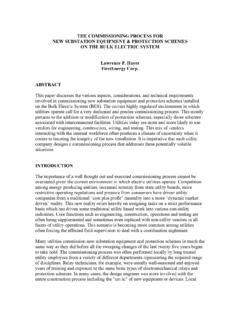Transcription of Innovations in Implementation of Trauma-Informed …
1 Innovations in Implementation of Trauma-Informed Care Practices in Youth Residential Treatment: A Curriculum for Organizational Change Victoria Latham Children in the child welfare system frequently Hummer experience trauma within the caregiving rela- University of South Florida tionship. These traumatic experiences may be compounded by system trauma and place these Nor n Dollard children at high risk of emotional disorders University of South Florida and placement in out-of-home (OOH) men- John Robst tal health treatment programs. This article University of South Florida reviews the literature on trauma and children in the child welfare system and discusses a Mary I.
2 Armstrong study of Trauma-Informed practices in OOH. University of South Florida treatment programs and the curriculum Creat- ing Trauma-Informed Care Environments, which resulted from study findings. Child Welfare Vol. 89, No. 2 79. Child Welfare Vol. 89, No. 2. hildhood traumatic stress refers to both physical and emotional C responses of children to life-threatening events that cause or threaten injury, such as child sexual abuse, physical abuse, or family violence (Child Welfare Collaborative Group, National Child Traumatic Stress Network [NCTSN], and California Social Work Education Center, 2008).
3 The types of trauma prevalent among chil- dren and families in child welfare include abuse and neglect, expo- sure to violence, and exposure to parental substance abuse. Child maltreatment also co-occurs with risk factors within disadvantaged environments, such as neighborhood violence and inadequate com- munity resources (Edleson, 1999; Rudo, Powell, & Dunlap, 1998). As children move through the child welfare and juvenile court systems, they often encounter additional stressful, frightening, and emotionally overwhelming experiences through system-generated trauma (Ryan, Bashant, & Brooks, 2006), such as multiple place- ments and frequent changes in schools and peer groups (Ko, Ford, Kassam-Adams, Berkowitz, Wilson, Wong, Brymer, & Layne, 2008).
4 Because of the increased risk for emotional and behavioral chal- lenges experienced by children in child welfare (Landsverk, Burns, Stambaugh, & Rolls Reutz, 2009), these placement changes often include out-of-home (OOH) mental health treatment programs, including residential treatment programs. Consequently, there are high rates of trauma exposure in the histories of youth in OOH set- tings (LeBel & Stromberg, 2004). The high rate of dependent children and youth in OOH mental health treatment programs, combined with the recognition of the need for trauma-related training and resources from Florida's serv- ice provider community, provided the impetus for evaluating the degree to which Trauma-Informed care was being implemented in Florida's OOH mental health treatment programs.
5 The findings from the eight nominated residential mental health settings in Florida who participated in the assessment were used to develop a comprehensive Acknowledgments: This work was funded in part by the Florida Agency for Health Care Administration, con- tract MED-078. The University of South Florida's Institutional Review Board approved the study described herein. 80. Hummer et al. Child Welfare curriculum that highlights successful Implementation and sustain- ability of cultural change within organizations that are adapting Trauma-Informed and trauma-specific care.
6 This curriculum merges the current research on models of Trauma-Informed care with theories of organizational change and development (Hodges, Hernandez, Nesman & Lipien, 2002) and Implementation research (Fixsen, Naoom, Blas , Friedman, & Wallace, 2005). Background There is a growing recognition that chronic and complex trauma is at the core of many behavioral and psychological disorders of children and adolescents (Cook, Blaustein, Spinnazzola, Van der Kolk, & the Complex Trauma Task Force, 2003), and that research-proven practice is essential for e ective treatment of this population.
7 Complex trauma refers to problems from exposure to multiple traumatic events and the resulting short- and long-term e ects of such exposure. This generally occurs within the caregiving system, which suggests that interventions that occur within the context of relationships are the desired avenue for healing (Perry, Pollard, Blakley, Baker, & Vigilante, 1995). Exposure to early, repeated, and multiple episodes of abuse increases the risk for complex trauma, a ecting the self-regulatory, behavioral, and emotional systems of traumatized children (Cook et al.)
8 , 2007). Therefore, the need for intervention within the caregiving relationship also extends to rela- tionships between direct-care sta and children in mental health treat- ment programs. Residential programs that serve traumatized children and youth should be first and foremost a sanctuary with an abun- dance of environmental and relational safeguards to prevent further retraumatization (Bloom, Bennington-Davis, Farragher, McCorkle, Nice-Martin, & Wellbank, 2003). The research literature distinguishes between two types of trauma treatment: trauma-specific and Trauma-Informed .
9 Trauma-specific services directly address complex trauma and facilitate the child's recovery through individual or group therapy specifically focusing on trauma recovery; central goals are achieving safety in one's envi- ronment, developing skills in emotion regulation and interpersonal 81. Child Welfare Vol. 89, No. 2. functioning, making meanings about traumatic events, and enhanc- ing resiliency and integration into a social network (NCTSN, 2007). Trauma-specific treatment approaches may include such interven- tions as psychological debriefing, psychological education, cognitive behavioral therapy, and psychotropic medication (Cohen, Mannarino, Berliner, & Deblinger, 2000).
10 Trauma-Informed services address the dynamics and impact of complex trauma on youth through a focus on avoiding inadvertently retraumatizing them when providing assistance within the mental health system. For example, in agencies using Trauma-Informed prac- tices, all sta that interact with youth may be trained to recognize and respond therapeutically to manifestations of trauma such as act- ing out behaviors. A Trauma-Informed organizational culture sup- ports and sustains trauma-specific services as they are introduced ( Jennings, 2004, p.)








